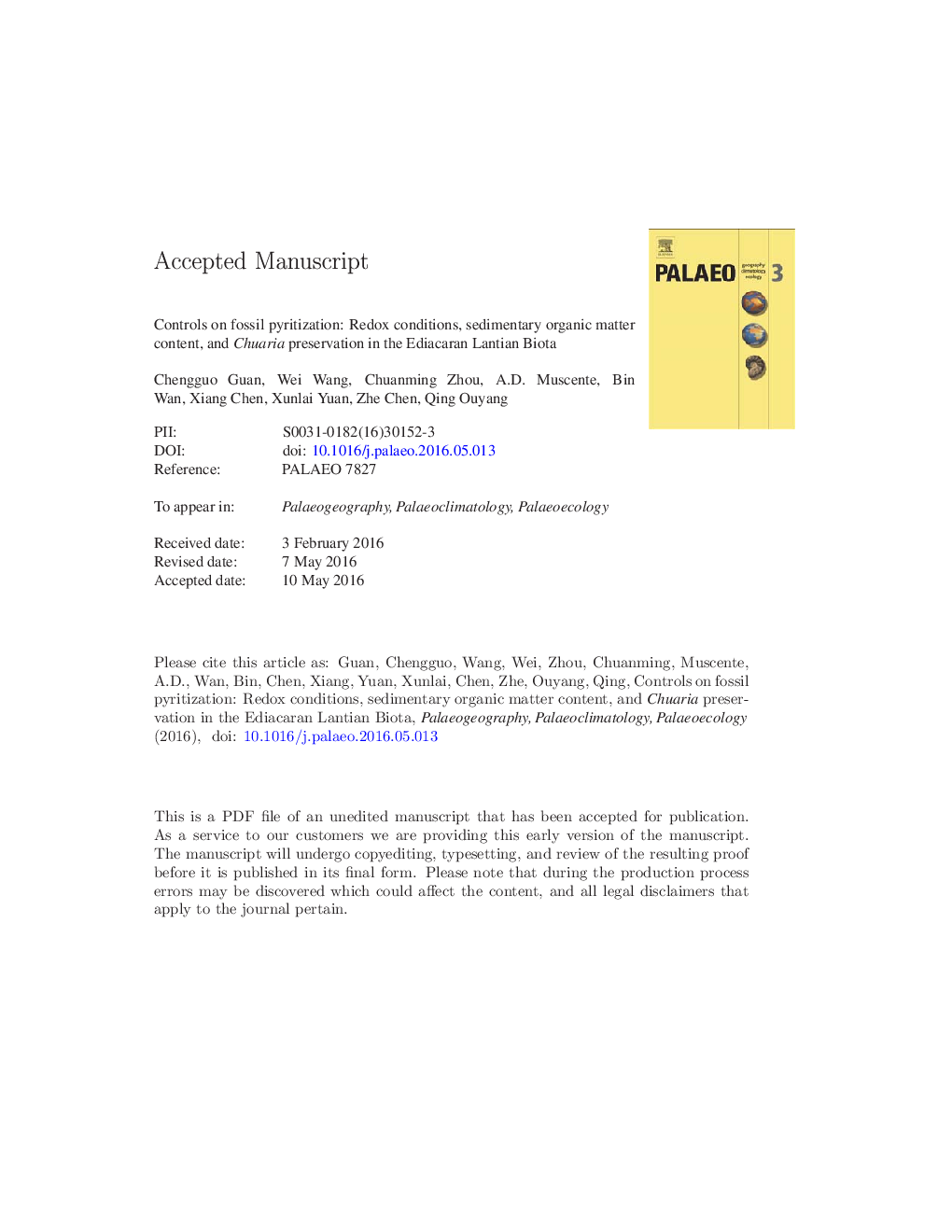| کد مقاله | کد نشریه | سال انتشار | مقاله انگلیسی | نسخه تمام متن |
|---|---|---|---|---|
| 5755948 | 1622118 | 2017 | 44 صفحه PDF | دانلود رایگان |
عنوان انگلیسی مقاله ISI
Controls on fossil pyritization: Redox conditions, sedimentary organic matter content, and Chuaria preservation in the Ediacaran Lantian Biota
دانلود مقاله + سفارش ترجمه
دانلود مقاله ISI انگلیسی
رایگان برای ایرانیان
موضوعات مرتبط
مهندسی و علوم پایه
علوم زمین و سیارات
فرآیندهای سطح زمین
پیش نمایش صفحه اول مقاله

چکیده انگلیسی
Pyritization represents a major taphonomic pathway for exceptional preservation of soft tissues. Although various Ediacaran Lagerstätten contain pyritized fossils, the controls on this taphonomic pathway prior to the Precambrian-Phanerozoic transition have only recently received significant attention, and no studies have yet thoroughly investigated environmental conditions facilitating exceptional preservation via pyritization in the early Ediacaran. Here, we investigate the preservational environments of macroscopic fossil Chuaria in the early Ediacaran Lantian Formation of South China using petrographic, electron microscopic, and geochemical data. Chuaria occur as pervasively pyritized (spheroid-shaped) globose and non-pervasively pyritized (disk-shaped) subglobose fossils in different stratigraphic intervals. Although these different stratigraphic intervals are similar in terms of total sulfur (TS, ~Â 5%), subglobose Chuaria shales have greater total organic carbon (TOC, ~Â 7.9%) contents than globose Chuaria shales (~Â 3.6%). Additionally, petrographic observations and TOC-TS cross-plots suggest that, whereas globose fossils were preserved under suboxic bottom waters, the subglobose fossils were preserved in euxinic bottom waters. Overall, these results affirm that pyritization in the Precambrian was generally favored in organic-poor, reactive iron-rich, sulfate-rich environments probably with slow sedimentation rates. When organics were scarce and reactive iron was abundant, bacterial sulfate reduction (BSR) created hydrogen sulfide and reactive iron concentration gradients around fossils, which kinetically and thermodynamically favored rapid and pervasive pyritization, as observed in globose Chuaria. Conversely, when organics were abundant and reactive iron/sulfate availabilities were limited by widespread BSR, fossils were relatively rapidly buried beneath the BSR metabolic zone of sediment, where they were principally preserved as aluminosilicified carbonaceous fossils that were compacted into subglobose forms. Thus, preservational variations among pyritized fossils in the Ediacaran may reflect differences in sedimentary organic matter content and/or bottom water redox chemistry.
ناشر
Database: Elsevier - ScienceDirect (ساینس دایرکت)
Journal: Palaeogeography, Palaeoclimatology, Palaeoecology - Volume 474, 15 May 2017, Pages 26-35
Journal: Palaeogeography, Palaeoclimatology, Palaeoecology - Volume 474, 15 May 2017, Pages 26-35
نویسندگان
Chengguo Guan, Wei Wang, Chuanming Zhou, A.D. Muscente, Bin Wan, Xiang Chen, Xunlai Yuan, Zhe Chen, Qing Ouyang,